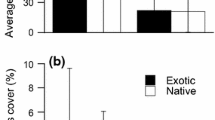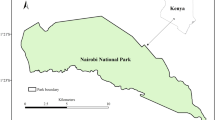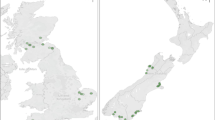Abstract
Due to the lack of a co-evolutionary history, the novel defenses presented by introduced plants may be insurmountable to many native insects. Accordingly, non-native plants are expected to support less insect biomass than native plants. Further, native insect specialists may be more affected by introduced plants than native generalist herbivores, resulting in decreased insect diversity on non-native plants due to the loss of specialists. To test these hypotheses, we used a common garden experiment to compare native insect biomass, species richness, and the proportion of native specialist to native generalist insects supported by 45 species of woody plants. Plants were classified into three groupings, with 10 replicates of each species: 15 species native to Delaware (Natives), 15 non-native species that were congeneric with a member of the Native group (Non-native Congeners), and 15 non-native species that did not have a congener present in the United States (Aliens). Native herbivorous insects were sampled in May, June, and July of 2004 and 2005. Overall, insect biomass was greater on Natives than Non-native Congeners and Aliens, but insect biomass varied unpredictably between congeneric pair members. Counter to expectations, Aliens held more insect biomass than did Non-native Congeners. There was no difference in species richness or the number of specialist and generalist species collected among the three plant groupings in either year, although our protocol was biased against sampling specialists. If these results generalize to other studies, loss of native insect biomass due to introduced plants may negatively affect higher trophic levels of the ecosystem.

Similar content being viewed by others
Abbreviations
- USDA:
-
United States Department of Agriculture
References
Agrawal AA, Kotanen PM, Mitchell CE et al (2005) Enemy release? An experiment with congeneric plant pairs and diverse above- and belowground enemies. Ecology 86:2979–2989
Andow DA (1991) Vegetational diversity and arthropod population response. Ann Rev Entomol 36:561–568
Andow DA, Imura O (1994) Specialization of phytophagous arthropod communities on introduced plants. Ecology 75:296–300
Arnett RH Jr, Thomas MC, Skelley PE et al (2002) American beetles Volume 2 Polyphaga: scarabaeoidea through Curculionoidea. CRC Press, Boca Raton
Auerbach M, Simberloff D (1988) Rapid leaf miner colonization of introduced trees and shifts in sources of herbivore mortality. Oikos 52:41–50
Bernays EM, Graham M (1988) On the evolution of host specificity in phytophagous arthropods. Ecology 69:886–892
Blossey B (1999) Before, during and after: the need for long-term monitoring in invasive plant species management. Biol Inv 1:301–311
Blossey B, Nötzold R (1995) Evolution of increased competitive ability in invasive nonindigenous plants: a hypothesis. J Ecol 83:887–889
Brooks ML, D’Antonio CM, Richardson DM et al (2004) Effects of invasive alien plants on fire regimes. BioScience 54:677–688
Chapman RF (1982) Chemoreception: the significance of receptor numbers. Adv Insect Physiol 16:247–356
DeLong DM (1948) The leafhoppers, or cicadellidae of Illinois (eurymelinae-balcluthinae). Bull Ill Nat Hist Surv 24:97–376
Dirr M (1998) Manual of woody landscape plants. Stipes, Champaign
Eastop VF (1973) Deductions from the present day host plants of aphids and related species. Symp Roy Entomol Soc Lond 6:157–177
Elton CS (1958) The ecology of invasions by animals and plants. John Wiley, New York
Ehrlich PR, Raven PH (1965) Butterflies and plants: a study in coevolution. Evolution 19:586–608
Fenner M, Lee WG (2001) Lack of pre-dispersal seed predators in introduced Asteraceae in New Zealand. NZ J Ecol 25:95–99
Futuyma DJ, Gould F (1979) Associations of plants and insects in a deciduous forest. Ecol Monogr 49:33–50
Goeden RD (1974) Comparative survey of the phytophagous insect faunas of Indian thistle, Cardus pycnocephalus, in southern California and southern Europe relative to biological weed control. Environ Entomol 3:464–474
Hamilton KGA (1982) The insects and arachnids of Canada Part 10. The spittlebugs of Canada (Homoptera: Cercopidae). Canadian Government Publishing Centre, Ottawa
Hokkanen HMT, Pimentel D (1989) New associations in biological control theory and practice. Can Entomol 121:829–840
Kareiva P (1982) Influence of vegetation texture on herbivore populations: resource concentration and rival movement. In: Denno RF, McClure MS (eds) Variable plants and herbivores in natural and managed systems. Academic Press, New York, pp 259–289
Keane RM, Crawley MJ (2002) Exotic plant invasions and the enemy release hypothesis. TREE 17:164–170
Kolar CS, Lodge DM (2001) Progress in invasion biology: predicting invaders. Trend Ecol Evol 16:199–204
Krebs CJ (1999) Ecological methodology. Benjamin/Cummings, Menlo Park
Leger EA, Forister ML (2005) Increased resistance to generalist herbivores in invasive populations of the California poppy (Eschscholzia californica). Divers Distrib 11:311–317
Lodge DM (1993) Species invasions and deletions. In: Kareiva P, Kingsolver JG, Huey RB (eds) Biotic interactions and global change. Sinauer, Sunderland, pp 326–387
Matthews ED, Lavoie OL (1970) Soil survey of New Castle County, Delaware. United States Department of Agriculture, Soil Conservation Service, Washington
McAvoy WA, Bennett KA (2001) The flora of Delaware: an annotated checklist. Delaware Department of Natural Resources and Environmental Control, Dover
Parker JD, Hay ME (2005) Biotic resistance to plant invasions? Native herbivores prefer non-native plants. Ecol Lett 8:959–967
Pimentel D, Zuniga R, Morrison D (2005) Update on the environmental and economic costs associated with alien-invasive species in the United States. Ecol Econ 52:273–288
Price PW (1983) Hypotheses on organization and evolution in herbivorous insect communities. In: Denno RF, McClure MS (eds) Variable plants and herbivores in natural and managed systems. Academic Press. New York, pp 559–598
Qian H, Ricklefs RE (2006) The role of exotic species in homogenizing the North American flora. Ecol Lett 9:1293–1298
Randall J (1996) Weed control for the preservation of biological diversity. Weed Technol 10:370–383
Reichard SE (1996) Prevention of invasive plant introductions on national and local levels. In: Luken JO, Thieret JW (eds) Assessment and management of plant invasions. Springer-Verlag, New York, pp 215–227
Reichard SH, Hamilton CW (1997) Predicting invasions of woody plants introduced into North America. Conserv Biol 11:193–203
Rejmánek M, Richardson DM (1996) What attributes make some plant species more invasive? Ecology 77:1655–1661
Rejmánek M (1999) Invasive plant species and invasible ecosystems. In: Sandlund OT, Schei PJ, Vilken A (eds) Invasive species and biodiversity management. Kluwer, Dordrecht, pp 79–102
Root RB (1973) Organization of a plant-arthropod association in simple and diverse habitats: the fauna of collards (Brassica oleracea). Ecol Monogr 43:95–124
Slater JA, Baranowski RM (1978) How to know the true bugs (Hemiptera-Heteroptera). Wm. C. Brown Company Publishers, Dubuque
Southwood TRE (1961) The number of species of insects associated with various trees. J Anim Ecol 30:1–8
Southwood TRE (1984) Insect-plant adaptations. In: Ciba foundation symposium 102, origins and development of adaptation. Pitman, London, pp 138–151
Staples GW, Herbst DR, Imada CT (2000) Survey of invasive or potentially invasive plants in Hawaii. Bishop Museum Occas Pap 65:1–35
Stehr FW (1987) Immature insects, vols. I and II. Kendall/Hunt Publishing Company, Dubuque
Strong DR, Lawton JH, Southwood R (1984) Insects on plants: community patterns and mechanisms. Harvard University Press, Cambridge
Tallamy DW (2004) Do alien plants reduce insect biomass? Conserv Biol 18:1689–1692
USDA, NRCS (2003) The PLANTS Database, Version 3.0 (http://www.plants.usda.gov) Data compiled from various sources by Mark W. Skinner. National Plant Data Center, Baton Rouge, Louisiana
Vila M, Weiner J (2004) Are invasive plant species better competitors than native plant species? — evidence from pair-wise experiments. Oikos 105:229–238
Wagner DL (2005) Caterpillars of Eastern North America. Princeton University Press, Princeton
Ward LK, Hackshaw A, Clarke RT (1995) Food-plant families of British insects and mites: the influence of life form and plant family. Biol J Linn Soc 55:109–127
White RE (1983) A field guide to the beetles. Houghton Mifflin Company, New York
Wilcove DS, Rothstein D, Dubow J et al (1998) Quantifying threats to imperiled species in the United States. BioScience 48:607–615
Williamson M (1996) Biological Invasions. Chapman & Hall, London
Wilson EO (1987) The little things that run the world (The importance and conservation of invertebrates). Conserv Biol 1:344–346
Wolfe LM (2002) Why alien invaders succeed: support for the escape-from-enemy hypothesis. Am Nat 160:705–711
Yela JL, Lawton JH (1997) Insect herbivore loads on native and introduced plants: a preliminary study. Entomol Exp Appl 85:275–279
Zuefle ME (2006) The impact of non-native woody plants on the native herbivorous insect community of northern Delaware. Thesis, University of Delaware
Acknowledgments
The Northern Research Station of the U.S. Forest Service (RWU NE-4502) funded this project. We thank the Kranz family and White Clay Creek State Park for housing the study site and John Pesek for continued statistical advice. The editor and an anonymous reviewer provided helpful criticism of the manuscript. We also thank the many volunteers who helped with the planting. Jennie Witmer assisted with plot maintenance and data collection.
Author information
Authors and Affiliations
Corresponding author
Rights and permissions
About this article
Cite this article
Zuefle, M.E., Brown, W.P. & Tallamy, D.W. Effects of non-native plants on the native insect community of Delaware. Biol Invasions 10, 1159–1169 (2008). https://doi.org/10.1007/s10530-007-9193-y
Received:
Accepted:
Published:
Issue Date:
DOI: https://doi.org/10.1007/s10530-007-9193-y




